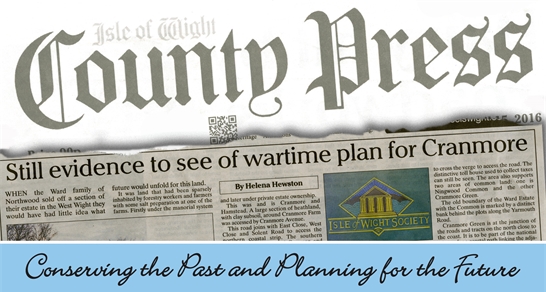January 2017
When the Ward family of Northwood sold off a section of their estate in the West Wight they would have had little idea what future would unfold for this land. It was land that had been sparsely inhabited by forestry workers and farmers with some salt preparation at one of the farms. Firstly under the manorial system and later under private estate ownership. This was and is Cranmore and Hamstead. A large section of heathland, with clay subsoil, around Cranmore Farm was accessed by Cranmore Avenue, This road joins with East Close, West Close and Solent Road to access the northern coastal strip. The southern boundary was Ningwood Common and the Yarmouth Road. It supported mixed grazing, woodland, plus limited arable.
This type of a land occupation would have continued but for the First World War. Land was sold to provide sites for soldiers who wished to have small holdings. The scheme was called Plot Land Development and was unusual in Britain. The idea was to allocate three acres, per applicant, that could be self-sustaining. When looking at maps now it can be seen that boundaries were irregular in some cases and three acres became a guideline. New residents were able to build themselves two bedroom bungalows, clear the land, keep chickens, pigs, goats and sheep, grow produce and aim for self-sufficiency. Many dwellings have been upgraded but there are still a few originals to be seen.
The scheme was continued after WW11 but the promise of free passage to Canada with 50acre plots rather destroyed the marketability on the Island. During WW11 the straightness of Cranmore Avenue was mistaken by German Intelligence for a runway and was bombed.
Hamstead Road is classed as Ancient Highway and belongs to the Crown. It has no tarmac surface. The width is 45 ft with 15ft verges including ditches. Any plot has to have deeded permission to cross the verge to access the road! The distinctive Toll House used to collect taxes can still be seen.
The area also supports two areas of Common Land one is Ningwood Common and the other Crammore Green. The old boundary of the Ward Estate with the Common is marked by a distinct bank behind the plots along the Yarmouth Road. Cranmore Green is at the junction of the roads and tracts on the north close to the coast. It is to be part of the national scheme for A Coastal Path linking the adjacent Bouldnor Marine Heritage Site. In the 1960s and 1970s there were proposals for houses and a school and a Community Tip but residents fought against both of these for environmental reasons.
Cranmore and Hampstead are under the AONB umbrella. Ningwood Commom has SSSI status to protect species of newts, door-mice butterflies and moths found there.
Cranmore is one of the many places on the Island with special history and can be said to illustrate Island character not only in its landscape but in its residents too.
[Go Back]

